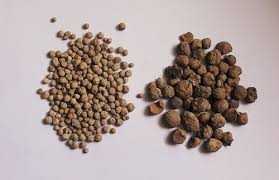
Sintered Flyash Lightweight Aggregates
Description:
Building Material Category: Aggregates
Building Component Type: Wall, Roof, Floor and Slab
Alternative for Conventional Building Material: Traditional aggregates like natural gravel and crushed stone used in concrete and masonry
Introduction: Sintered flyash lightweight aggregates are an innovative construction material created by heating flyash, a byproduct of coal combustion, to high temperatures until it forms lightweight, porous granules. These aggregates are used to produce lightweight concrete and other building products, offering improved thermal insulation and reduced structural load.
The sintering process not only changes the physical characteristics of the flyash but also improves its structural properties. The resulting lightweight aggregates have a cellular, porous structure that contributes to their low density. This unique structure provides several benefits: it reduces the overall weight of concrete and other building materials, making them easier to handle and transport. Additionally, the porosity of the aggregates enhances their thermal insulation properties, contributing to better energy efficiency in buildings.
Sintered flyash lightweight aggregates are primarily used in the production of lightweight concrete, which is employed in a variety of construction applications including walls, floors, and roof systems. The lightweight nature of the concrete helps in reducing the load on structural elements and foundations, thereby potentially lowering construction costs and enabling the design of more efficient and sustainable building systems. Moreover, the improved thermal insulation properties help in maintaining stable indoor temperatures, leading to reduced energy consumption for heating and cooling.
Composition: The primary material used is flyash, a byproduct from coal-fired power plants. Additives may include binders and stabilizers to enhance the material properties. The flyash is subjected to high-temperature sintering to form lightweight, expanded particles.
Applicability in Climatic Zone: For Warm and humid climates it provides excellent thermal insulation, reducing heat gain and improving indoor comfort. For temperate climates it enhances energy efficiency by improving thermal resistance and reducing heating costs. For hot and dry climates it provides low thermal conductivity which helps in maintaining cooler indoor temperatures.
Use: It is used in lightweight concrete blocks, panels, and other construction elements. It is ideal for reducing the overall weight of structures, which is beneficial for both new constructions and retrofitting existing buildings.
Thermal Performance: The porous structure of sintered fly ash aggregates provides effective thermal insulation, helping to maintain consistent indoor temperatures. It contributes to reduced energy consumption for heating and cooling by enhancing the thermal performance of building envelopes.
Thermal Conductivity: It typically ranges from 0.1 to 0.3 W/m·K, significantly lower than traditional aggregates, contributing to better thermal insulation.
Thermal Transmittance: It has low thermal transmittance values due to the lightweight and insulating properties of the aggregates, improving the building's thermal performance.
Reduction in CO2 Emission: It utilizes flyash, a waste byproduct, reducing the need for virgin raw materials and minimizing environmental impact. The enhanced insulation properties lead to lower energy consumption for heating and cooling, reducing overall CO2 emissions over the building's lifetime.
Salient Features:
- Lightweight: It reduces the overall weight of the building structure, leading to lower transportation and construction costs.
- High Insulating Value: It has excellent thermal insulation properties, contributing to energy efficiency and comfort.
- Sustainable: It utilizes industrial byproducts, promoting recycling and reducing landfill waste.
- Fire Resistance: It typically offers good fire resistance due to the inorganic nature of the material.
Indian Codes:
- IS 383:2016 - Specification for Coarse and Fine Aggregates from Natural Sources for ConcreteProvides guidelines on the use of aggregates, including those that may be relevant for lightweight aggregates.
- IS 456:2000 - Code of Practice for Plain and Reinforced ConcreteIncludes provisions for the use of various types of aggregates in concrete.
- IS 1498:1970 - Classification and Identification of Soils for General Engineering PurposesMay include guidelines relevant for understanding the behavior of different aggregate types in concrete.
International Codes:
- Eurocode 2: Design of Concrete StructuresProvides standards for the use of various types of aggregates in concrete, including lightweight aggregates.
- ACI 318: Building Code Requirements for Structural ConcreteIncludes guidelines for using different types of aggregates in structural concrete.
- ASTM C330/C330M: Standard Specification for Lightweight Aggregates for ConcreteDefines the requirements and testing methods for lightweight aggregates, including sintered flyash.
Manufacturers:
- LITAGG Industries Pvt Ltd (LIPL) SINTAGG- https://www.litagg.in/sintagg.php
Sources: